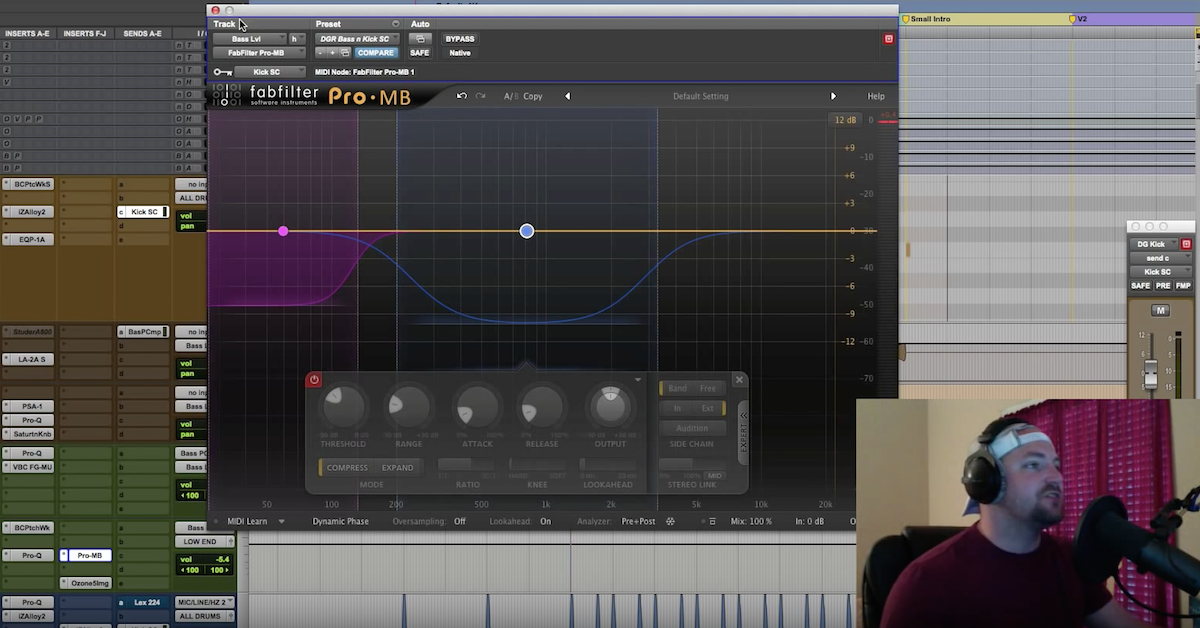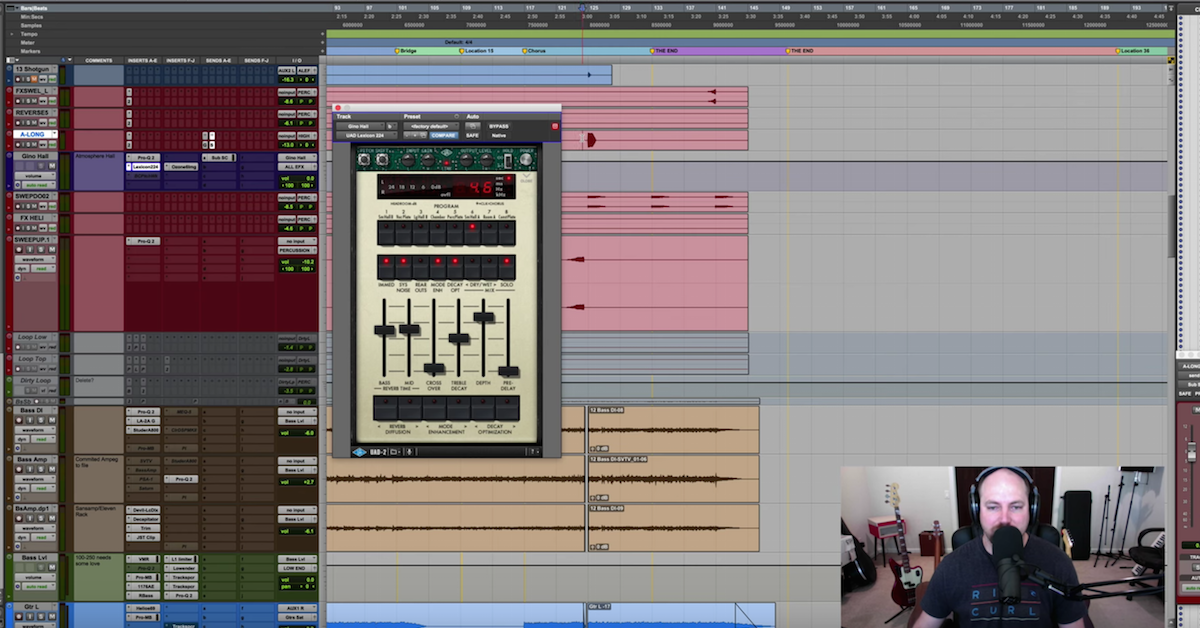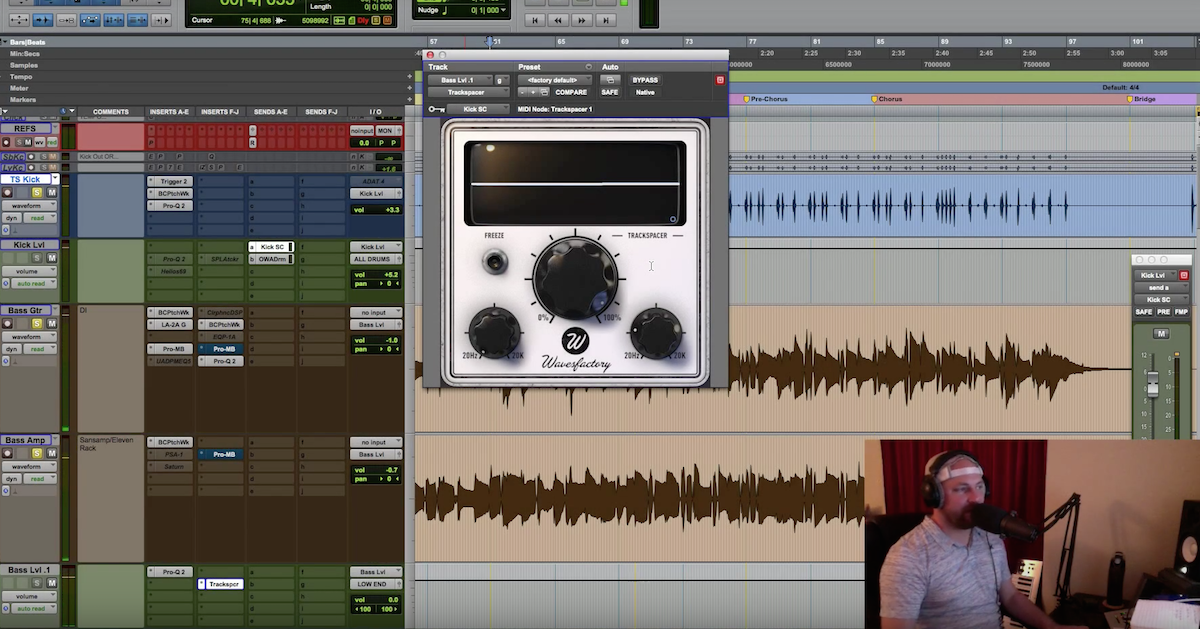The A-Z of Sonic Quality in a Mix
Article Content
Join me as I try to make it once through the english alphabet and define some of the adjectives we use to describe sonic quality.
Airy
Let’s start simple. You’ve probably heard certain vocal recordings referred to as having an “airy” quality. I like to think of airy vocals as ones that have a pleasant top end (high-frequencies), and a nicely defined sense of space. I think it’s important to discern airy from roomy, though. Sticking a microphone 10 feet away from a singer is cool, but won’t necessarily leave you with airy results.
My favorite microphone for airy vocals is usually an AKG C414, which to my ears, does a great job of capturing the sound source and what happens in the immediate space “around the singer.” In terms of processing, you can add airiness by focusing in on the 10k and up range. The Maag Audio EQ4 features an “Air Band” that I absolutely love for adding air to individual instruments, or an entire mix.
Boominess
A lack of definition and too much overall volume in the 20-250Hz range creates boominess. This creates the sense that instruments that create these low frequencies (such as kick drum and bass) are overpowering the rest of your mix.
Some precise subtractive equalization with the FabFilter Pro-Q 2 or a similar “surgical” EQ, and perhaps multiband compression/dynamic equalization that focuses on cleaning up that range generally does the trick, but be careful to not get too heavy-handed with these types of processing. Remember that a lot can be accomplished with fader rides, as instruments like bass typically suffer from resonating notes that “poke out” more than others.
Crisp/Crispy
I sort of have a problem with the term “crispy” as it relates to audio. I’ve worked with clients that dictated to me that they wanted their vocals/final mixes to have a crispy quality. Looking back, most of them probably meant “crisp” which I believe to mean clear, hi-fi and bright without being harsh.
Crispy to me is what happens when you add excessive high-frequency information, and perhaps compression/limiting. Some limiters tend to add brightness to program material, so it’s not a bad idea to take it easy on the additive EQ in the 10-20k range if your music is going to be mastered competitively loud.
Delicate
In a world where four-on-the-floor kick drums, buzzing synths and wailing vocals seem to dominate popular music, we’ve seemed to have lost our taste for delicate, gentle, nuanced sounds. This generally has more to do with how an instrument was played during the performance, whether it be piano, guitar or human voice. Dynamics are important here. Be careful to not over-compress parts that are meant to be perceived as delicate, perhaps try fader riding or subtle ducking of elements around the part.
Extended
This refers to low-end definition all the way down to 20hz. There is a very fine line between extended and boomy, so be careful to balance frequencies from about 250 Hz and down if you’re looking for an extended low end. There are some excellent low frequency exciters out there that can help achieve clear, tight, subby bass and kick sounds (Brainworx bx_boom!, bx_subsynth, and UAD Little Labs Voice of God) without causing problems, but generally, there are no simple fixes, so learn your equalizers.
Full
Good definition across the entire frequency spectrum, with an emphasis on low to low-mid frequencies. This requires a multi-step approach to achieve fullness (for individual parts or an entire mix.) I’d start with subtractive equalization to remove unwanted content, subtle compression to control harsh transients, and then perhaps some tape saturation to add warmth and pleasantness. The UAD Studer A800 sometimes seems like a magical plugin when it comes to making material sound full, as it deals with both transient and frequency information simultaneously.
Glue
Think about recorded music in the 60’s and 70’s — it was usually an entire band playing together in the same space, through a vintage console, committed to analog tape. Of course it would sound cohesive. With today’s productions generally consisting of a patchwork approach by pulling from different sample libraries and playing parts separately (if at all, if I’m being honest), we sort of lose the sense that the elements exist within the same musical context. For this, an SSL-style Buss Compressor can do the trick. There are plenty of companies that make emulations of the famed compressor, with my favorite being “The Glue” from Cytomic.
Hashy
Did you know that my least favorite piece of a drum kit to mix is the hi-hat? Unless it’s groovy 16th notes or a well-played gallop, I despise hi-hats and will probably bring the close-miked signal way down. I think of “hashy” as the build-up of sustained high frequencies, so hi-hat (especially played open) lends itself to hashiness. One of my new favorite plugins, soothe by oeksound, does wonders for material like this. Reach for a dynamic equalizer or even a de-esser, otherwise.
Intense
In some cases, I need to make musicians seem as if they were playing their instrument harder than they were as they were being recorded. In this event, compression can do just the trick. I am loving the new UAD Distressor for this application, among many others.
Juicy
I’ll admit I had a hard time finding an adjective that began with J… regardless, my friend and contemporary, Phil Mantione, is always talking about the latest “juicy” synth modules that he bought.
I think of juicy as authentic, analog sounding, almost like you’re feeling the flow of electricity when experiencing a sound. By that definition, when it comes to obtaining pure juiciness, nothing replaces analog gear, but plugin companies are still doing a fantastic job in emulating the vintage tools that brought us ‘juice’ through the decades.
Knock
I love getting my snares to “knock”. I like to think of a knock-y snare as one with an emphasized transient obtained with compression, but also one that has not had its low-frequency content compromised. Sometimes compressors can really remove the low-end life from your material, so keep that in mind. The dbx 160 is my go-to for this.
Lively
Energetic, exciting, etc. I like using compression to make things sound more lively, as some compressors add some interesting pumping and breathing to the material. The Fairchild 660/670 is usually my favorite for this application. It’s been emulated by UAD, Waves and others. The Oxford Inflator is currently my favorite exciter plugin and definitely adds some life to virtually anything you process it with.
Muddiness
You’ll see engineers describe different ranges when describing muddiness, which I like to think of as an excess in low-mids to mids, and I personally use the 200-700 Hz range. Be careful to not do too much attenuation in that range, as it can make your material sound lifeless and thin.
Something interesting happens when using an SSL-style EQ in particular, to my ears boosting in the high frequencies almost seems like it’s simultaneously massaging/attenuating the lows (like a tilt shift of sorts.) I am aware that’s not actually what the EQ is doing. Try some top-end boosting if cutting in the 200-700 Hz range is killing the mids.
Noisy
One of my favorite records I ever worked on had a track of analog hum/hiss in the session for each song. I thought it was so unique and showed that they were dedicated to obtaining a vintage sound. If you do not want to “embrace the noise” the FabFilter Pro-G is the most flexible Gate I’ve ever used. You may also hear entire mixes, or genres of music referred to as noisy. Constant cymbal-bashing coupled with walls of distorted guitars make for noisy music. Again, sooth by oeksound, clever use of a De-Esser, or multiband compression can assist you in this case.
Open
This isn’t necessarily about brightness or clarity. I think that there are stereo field implications when talking about openness in a mix. Some Compressors like the Neve 33609, or Pultec-Style EQs really assist in creating a defined sense of space amongst individual elements of an arrangement. For stereo widening and enhancement, the SPL Vitalizer MK-2 (Native or UAD) does a great job and is a mainstay on my master buss.
Pillowy/Punchy
A twofer here. These are essentially opposites. Pillowy snares are the worst. Think of hitting a pillow—the resulting sound is soft, with a mellow attack, and not a lot of high-frequency information. That is not how I want my snare to sound, so I will add punch using a combination of compression and EQ. Too-fast of an attack can make snares sound pillowy rather than punchy, so pay attention to your settings. The aforementioned “The Glue” Compressor has a good punch, and for individual drums or room mics, I find myself using the Chandler Limited Zener Limiter.
Quiet
Use a Fader?
Round
Roundness, to me, means defined lines. You want very little roughness around the edges. Usually this term is reserved for kick drum or bass, but I could see describing a vocal sound or that of an entire mix as round. For bass, pay attention to the low-mids when EQing, use a slow, smooth compressor like an LA-2A, and perhaps some subtle tape saturation if you’re looking to achieve roundness.
Silky
Pleasant, smooth in the high frequency range. Lots of analog emulation Equalizers offer a silky high end. My favorite being the Neve 1073, and Manley Massive Passive, with the latter being one of the best choices for mastering work.
Thin
Another term you’ll hear somewhat often, thin refers a sound that is lacking in the low and low-mid ranges. While additive EQ can do the trick, I also really like using the Soundtoys Decapitator for adding some weight to Bass, Kick, Vocals, or pretty much anything that needs some heft.
Upfront
This is an important one considering lots of music today is meant to sound super insane, hyped, and close to the listener. Firstly, recording technique has a lot to do with obtaining an upfront sound. Close-miking, perhaps with a dynamic mic to take advantage of the proximity effect helps. One of my favorite Waves Plugins is the V-Comp, and I find that it does a great job of giving the impression that a vocalist is sitting closer to the listener.
Vibrant
This one is similar to juicy or lively. Organic. Fits within the musical context correctly, and at the same time doesn’t sound over-processed. I believe that vibrancy has more to do with how the music was performed than anything else, and there is not yet a plugin that can fix a boring band.
Wooly
Lack of definition, and an excess of low-mids. Perhaps as if the sound were covered by a blanket. I’ve read that wooly is “like the bad version of warm” and think that’s a good way to look at it. Remove wooliness with some surgical subtractive EQ, and perhaps a boosted high-shelf.
X-Factor
I am really reaching here as I get closer to the end of the alphabet, but let’s run with it. These are the intangibles that an engineer can add to a production. When someone gets so good with the tools and techniques that they can simply convey art and ideas onto the material, that’s when they are adding the X-Factor. High-end engineers are tastemakers and are paid to add their own vibe and character to a production.
Yiddle
This isn’t adjective for describing timbre, but is still an interesting term you could probably use to describe the musical talent of a past client:
“To strum on, get music out of, used disparagingly.”
Zero
An extremely important number in the world of audio. Try using a true peak limiter from the likes of iZotope or FabFilter to avoid going over zero, and if you are currently in a recording studio, please make sure to zero it out when you’re done.






